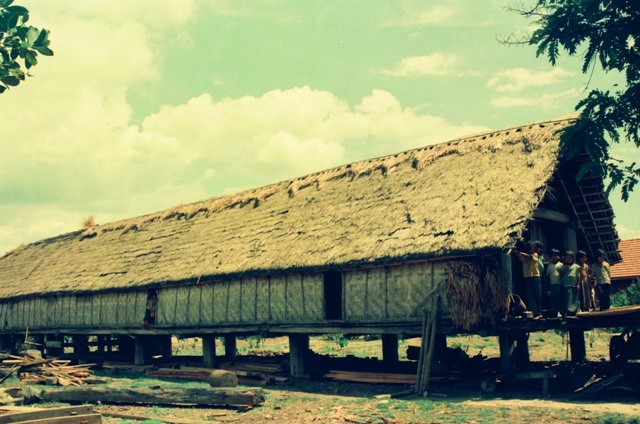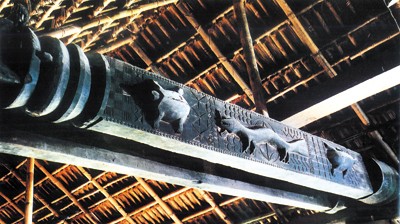(VOVworld) – The long house, which accommodates several generations of a clan, typifies the Ede ethnic group’s matriarchy. Whenever a girl living in a house gets married, the house is lengthened by one compartment. There’s a saying that compares the house to the distance the sound of a gong travels because when a gong is struck at one end of the house, its sound is barely heard at the other end.
 |
| (Photo: baodaklak.vn) |
The Ede long house is on stilts, made of timber and bamboo and roofed with straw. A house is normally built in a north-south orientation and resembles a boat. The length of a house is measured by its number of horizontal beams. Dr. Nguyen Duy Thieu, Director of the Vietnam Museum of Ethnology, says: “The longer the house is, the more prosperous the family is. There are some very, very long houses because girls of the 3rd or 4th generation have married and live there. According to a French document, during the French colonial time, Mr. Ama Ha’s house was more than 200 meters long”.
A house is divided into two main parts: the Gah, which makes up one third of the total area and the Ok. The Gah is used for receiving guests, family gatherings, worshipping, displaying valuable items and as a sleeping place for single men. The Gah and the Ok are separated by carved pillars called Kmeh Kpang. The eastern pillar stands near a plank bed where the family chief sits during family meeting, while the western pillar is built near a bench half a meter tall and 10-20 meters long where musicians play gongs and drums. Musical instruments are stored under the bench. There are two kitchens: one for guests and one for family members. Dam Thi Hop of the Vietnam Museum of Ethnology explains the details of a long house displayed at the museum: “This is the house of a rich family as can be seen by the items in the living room or Gah. In this area, family and communal activities take place. Many things are kept here such as jars of rice wine, gongs and bronze pots, which are very precious to the Ede”.
Inside the house, the Ede carve images of animals such as elephants, crabs and fish. Hop again: “Only families who possess real elephants carve elephant images in their houses. Other patterns are a reptile species called varans, dragons, crabs, and tortoises. People believe that images of varans carved in the wooden beams will bring them good luck and prevent harm. The images of dragons with their fish-shaped fins are distinctive Ede patterns”.
 |
| (Photo: daibieunhandan.vn) |
An Ede house has male and female staircases. The staircase for men is in the front, while the one for women is at the back of the house. Hop elaborates:“Traditionally, the house of a rich family has 2 front staircases which face the north. The female staircase is carved with images of female breasts and a crescent. The male staircase is almost plain”.
The Ede long house reflects the Ede culture of Vietnam’s central highland region, where people of several generations gather around a charcoal fire. Women weave clothes. Men repair hoes and other farm tools. The elderly recount epics to their grandchildren. All these activities are undertaken in the ample space of a long house.